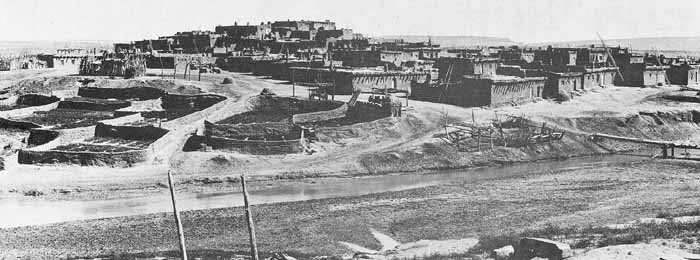|
|
Canku Ota |
|
|
(Many Paths) |
||
|
An Online Newsletter Celebrating Native America |
||
|
July 27, 2002 - Issue 66 |
||
|
|
||
|
This Date In |
||
|
North American Indian History |
||
|
from On This Date in North American Indian History at http://americanindian.net |
||
| July 27, 1757: | Ottawa warriors, and a few French soldiers attack a group of twenty-two barges commanded by British Lieutenant Colonel John Parker on Lake George in New York. The British forces have 160 men killed, and almost 150 men captured. Only two of the barges escape the fighting. |
|
|
|
| July 28, 1872: | Colonel Ranald S. Mackenzie and twelve officers and 272 enlisted men begin an extended patrol of the area surrounding the Texas Panhandle. They include twenty Tonkawa scouts. They are looking for renegade Indians. One of their engagements is called the "Battle of the North Fork of the Red River." It happens on September 29, 1872. |
|
|
|
| July 29, 1837: | Henry Dodge, representing the United States, and the Chippewa Indians sign a treaty (7 Stat., 536.) at St. Peters, Wisconsin. The Chippewas trade large land holdings for $9,500 immediately, $19,000 worth of supplies, and a release from their debts. |
|
|
|
 Mandan village overlooking a bluff with bullboats A painting by Bodmer |
|
| July 30, 1825: | The "Belantse-etoa or Minitaree" conclude a treaty (7 Stat., 261.) at the Lower Mandan Village. Nine chiefs and sixteen warriors sign the document. |
|
|
|
| July 31, 1763: | Captain James Dalyell, and 280 soldiers attack Pontiac's village at 2:30 am this morning. Pontiac is informed of Dalyell's plans, so he sets up an ambush at the Parent's Creek bridge with 400 Indians. When Dalyell's troops approach the bridge, the Indians attack. Twenty soldiers, including Dalyell, and seven Indians are killed in the fighting. The creek, near Detroit, is now called Bloody Run. Major Robert Rogers helps Dalyell's survivors to escape. |
|
|
|
| August 1, 1739: | Several Shawnee Chiefs sign a peace treaty with British Pennsylvania authorities not to become allies with any other country. The British agree to enforce previous treaties banning the sale of rum to the Indians. |
|
|
|
 Samson Occom (1723-1792) |
|
| August 2, 1792: |
Mohegan Samson Occom dies in New Stockbridge, New York. A protégé of Rev. Eleazar Wheelock, Occom learns numerous foreign languages, become an ordained minister, be the first Indian to preach in England, minister to many Indian tribes, and be instrumental in the establishment of Dartmouth College in New Hampshire. |
|
|
|
| August 3, 1761: | According to some records, a conference regarding land questions and the return of prisoners is held for the next ten days between representatives of the British in Pennsylvania and the Cayuga, Conoy, Delaware, Mahican, Nanticoke, Oneida and Onondaga Indians. |
|
|
|
| August 4, 1813: |
500 warriors of the White Stick faction of the Creeks gather in Coweta, across the river in Alabama from modern Columbus Georgia. With 200 Cherokee warriors, they make plans to attack a band of Red Stick Creeks, followers of Tecumseh, over 2,500 strong. The White Sticks are led by Tustunnuggee Thlucco and Tustunnuggee Hopoie. |
|
|
|
| August 5, 1570: | A Spanish colony expedition in sailing up the Chesapeake in Virginia, when they reach the area they will call Axaca somewhere near the Rappahannock. The local Indians will force the Spanish to abandon the effort. |
|
|
|
| August 6, 1840: | Hundreds of Comanches, led by Buffalo Hump, surround, and attack Victoria, Texas. In the next two days, fifteen settlers are killed in the fighting. The Comanches take several hundred head of livestock. |
|
|
|

This view of the pueblo of Zuni, New Mexico in the late 1800's gives a fairly accurate idea of the appearance of Hawiku, on its low hill, when the Coronado army attacked in July, 1540. |
|
| August 7, 1670: | Apache or Navajos attack the ancient Zuni Pueblo of Hawikuh. They burn the church, and kill the resident missionary. |
|
|
|
| August 8, 1699: | The Tohome Indians live along the Gulf Coast in Alabama and Mississippi. In Biloxi, they formally establish peaceful relations with the French. |
|
|
|
| August 9, 1823: | In June Arikara warriors attack an American expedition. A force of 500 Sioux warriors finds the Arikaras and a battle takes place. Colonel Henry Leavenworth soon arrives with his force of 200 soldiers. He reports his men kill fifty Arikaras and the Siouxs kill fifteen. The Sioux lose two warriors. |
|
|
|
|
For Information on This Date in Canada visit our friends at: |
|
Canadian
Aboriginal News |
|
|
||
|
|
||
| Canku Ota is a free Newsletter celebrating Native America, its traditions and accomplishments . We do not provide subscriber or visitor names to anyone. Some articles presented in Canku Ota may contain copyright material. We have received appropriate permissions for republishing any articles. Material appearing here is distributed without profit or monetary gain to those who have expressed an interest. This is in accordance with Title 17 U.S.C. section 107. | ||
|
Canku Ota is a copyright © 2000, 2001, 2002 of Vicki Lockard and Paul Barry. |
||
|
|
|
|
|
The "Canku Ota - A Newsletter Celebrating Native America" web site and its design is the |
||
|
Copyright © 1999, 2000, 2001, 2002 of Paul C. Barry. |
||
|
All Rights Reserved. |
||
